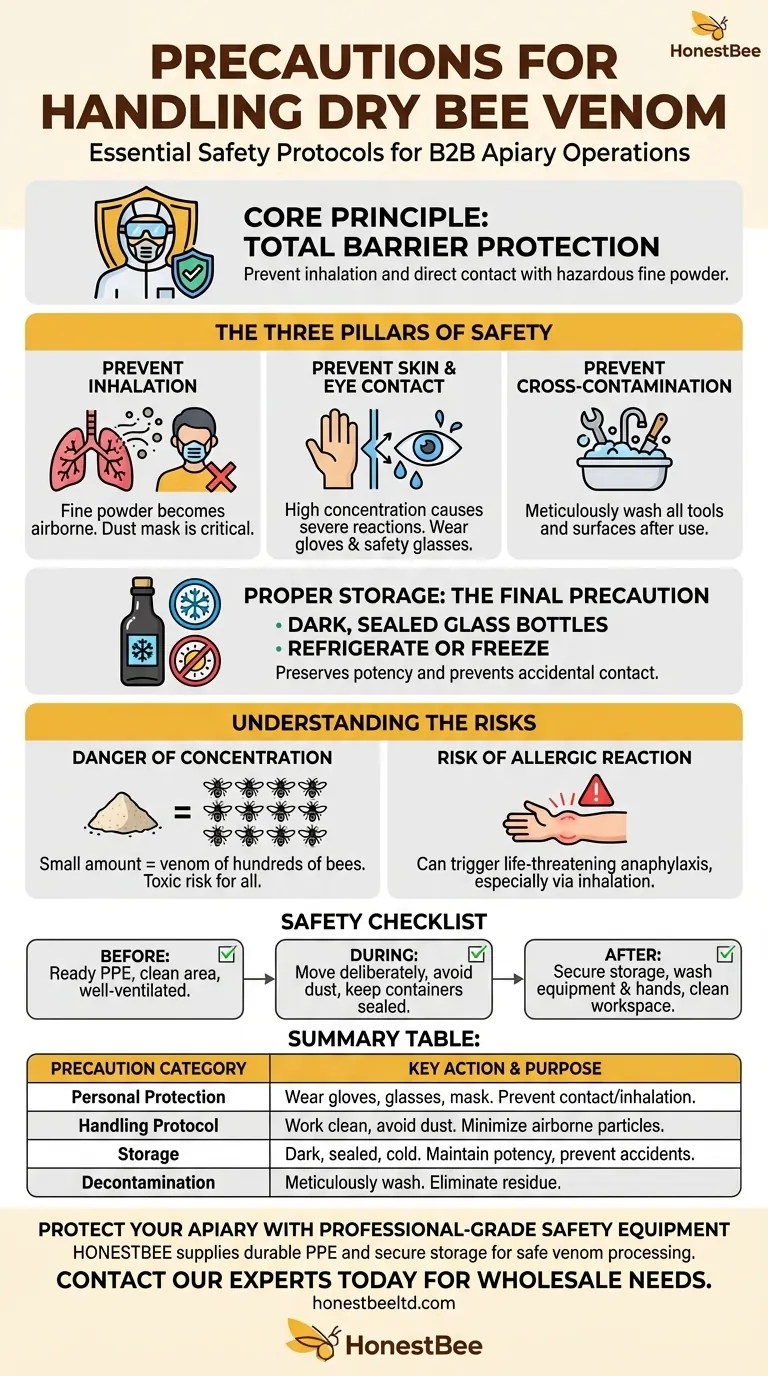The essential precautions for handling dry bee venom are to use comprehensive personal protective equipment (PPE) to prevent inhalation and direct contact. Due to its high concentration, dry venom must be treated as a hazardous fine powder. This includes wearing protective gloves, safety glasses, and a high-quality dust mask.
The core principle of handling dry bee venom is total barrier protection. You must prevent the fine, airborne particles from being inhaled or touching your skin and eyes, as its concentrated form poses a significant risk of severe allergic or toxic reactions.

The Three Pillars of Bee Venom Safety
Handling dry bee venom safely requires a protocol focused on preventing exposure through the three primary pathways: inhalation, direct contact, and cross-contamination.
Preventing Inhalation
Dry bee venom is a very fine powder that can easily become airborne. Inhaling these particles provides a direct route for the venom to enter your bloodstream.
A dust mask is not optional; it is a critical piece of equipment to prevent a potentially severe systemic reaction.
Preventing Skin and Eye Contact
The venom's high concentration means even minor skin contact can cause a significant localized reaction, including intense pain, swelling, and redness.
Always wear protective gloves to prevent absorption through the skin. Safety glasses are equally important to shield your eyes from airborne particles, which could cause extreme pain and damage.
Preventing Cross-Contamination
After handling is complete, the risk is not over. Venom residue can remain on surfaces and equipment, leading to accidental exposure later.
All tools, containers, and surfaces used in the process must be meticulously washed to neutralize and remove any lingering venom particles.
Proper Storage: The Final Precaution
Safe handling extends to how the venom is stored both before and after use. Proper storage preserves the venom's integrity and prevents accidental contact.
Protect from Light and Heat
Dried bee venom should be stored in dark, well-sealed glass bottles. This protects it from light, which can degrade its complex proteins.
The containers should be kept refrigerated or, preferably, frozen. Low temperatures are essential for maintaining the venom's stability and potency over time.
Why Storage is a Safety Issue
Leaving a hazardous material like concentrated bee venom in an unsealed or improperly labeled container is a major safety failure. Secure storage is the final step in a responsible handling protocol.
Understanding the Risks
The strictness of these precautions is directly related to the potency of the material. It's crucial to understand why the risks are so much higher than with a natural bee sting.
The Danger of Concentration
Dry bee venom is a purified, highly concentrated substance. A small amount of powder contains the venom of hundreds or even thousands of bees.
This means exposure to even a tiny, barely visible amount can be equivalent to receiving a massive number of stings simultaneously, leading to a toxic reaction even in non-allergic individuals.
The Risk of Allergic Reaction
For individuals with a bee sting allergy, any exposure to dry venom can trigger anaphylaxis, a life-threatening allergic reaction. The risk is significantly elevated due to the potential for inhalation.
A Simple Safety Checklist
Use this checklist to ensure a safe handling process from start to finish.
- Before you begin: Ensure all PPE is ready, your workspace is clean and well-ventilated, and all necessary equipment is laid out.
- During the process: Move deliberately to avoid creating airborne dust. Never touch your face, and ensure all containers remain sealed when not in immediate use.
- After you have finished: Securely store the venom, meticulously wash all equipment and your hands, and clean the workspace to prevent cross-contamination.
Treat this potent substance with the respect and caution it demands.
Summary Table:
| Precaution Category | Key Action | Purpose |
|---|---|---|
| Personal Protection | Wear gloves, safety glasses, and a dust mask. | Prevent inhalation and skin/eye contact with concentrated venom. |
| Handling Protocol | Work in a clean area; avoid creating dust. | Minimize airborne particles and risk of exposure. |
| Storage | Store in dark, sealed glass bottles; refrigerate or freeze. | Maintain potency and prevent accidental contact. |
| Decontamination | Meticulously wash all tools and surfaces after use. | Eliminate residue and prevent cross-contamination. |
Protect Your Apiary with Professional-Grade Safety Equipment
Handling potent substances like dry bee venom requires reliable, high-quality gear. HONESTBEE supplies commercial apiaries and beekeeping equipment distributors with the durable personal protective equipment and secure storage containers necessary for safe venom processing.
Ensure your team's safety and operational integrity. Contact our experts today to discuss your wholesale needs.
Visual Guide

Related Products
- Full Set Beekeeping Electronic Bee Venom Collector Machine Device for Bee Venom Collecting
- HONESTBEE Advanced Ergonomic Stainless Steel Hive Tool for Beekeeping
- Professional 3-Bar Frame Grip with Integrated Hive Tool
- Plastic Chinese Queen Grafting Tool for Bee Queen Rearing
- Beehive Handle and Frame Rest Cutting Machine: Your Specialized Hive Machine
People Also Ask
- How frequently should pollen be harvested from the traps? Ensure Optimal Hive Health & Superior Quality
- How frequently should pollen be collected for human consumption? Optimize Your Harvesting Schedule
- How is the venom collection apparatus utilized across multiple hives? A Guide to Efficient Rotation & Bee Health
- Where is the venom collection apparatus placed in a bee colony? Optimize Yield at the Hive Entrance
- How is bee venom typically collected using the electro-shock method? A Guide to Efficient, Non-Lethal Harvesting



















